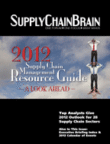
Visit Our Sponsors |
|
|
|
|
|
|
|
|
|
|
|
|
|
|
|
|
|
|
|
|
|
|
|
|
|
|
|
|
|
|
|
|
|
|
|
|
|
|

To date, the typical focus for retailers and manufacturers has been on reducing overall operational cost. A new, integrated model for managing the shelf is helping CPG manufacturers and retailers to maximize revenue, margins and in-stocks while removing costs across the value chain − the so-called "Demand-Driven Enterprise."
The new model was inspired by recent engagement with a large consumer products company having trouble managing retail customer relationships. Retailers changed their minds about promotions or placed/canceled large orders at the last minute. Resulting supply chain inefficiencies required extensive buffer inventories to support anticipated customer service levels. By integrating retailers' POS data into the planning process, the company gathered better insights into consumer behavior and worked with retailers to manage orders, promotions and inventory more effectively - ultimately improving inventory turns by 50 percent.
Demand-Driven Enterprise integrates planning and execution more collaboratively across manufacturers and retailers. This drives revenue and margin increases by better supporting assortment optimization, space optimization, trade funds management and demand planning while streamlining the supply chain. Although it requires alignment with the overall value chain − Sales, Marketing, Product Development and Finance − the power lies in five core concepts:
* Collaborative Category Management
CPG companies have dedicated account teams that work with specific retailers to research consumer behavior, shopper affinity, and new product introductions. By leveraging this data, account management teams can embed category strategies into improved assortment and store-level plan-o-gram recommendations.
* Demand Planning Synchronization
Most CPG companies forecast distribution center shipments rather than actual consumption data at the shelf, causing discrepancies between true demand and available supply. By tapping into POS data directly from the retailer, accurate analytics can be performed by Sales, Marketing and Demand Planning departments and assist account teams to accurately analyze promotion effectiveness.
* Trade Promotion Management and Optimization
The Demand Driven Enterprise drives accurate sales planning, measurably increasing sales through promotion optimization. CPG manufacturers can model the impact of different types of trade promotions to better understand the ROI associated with each trade instrument and better collaborate with retailers for future promotions.
* Inventory Planning Synchronization
Improved forecast accuracy is combined with other key data points from the retailer to calculate time-phased net inventory requirements for each node within the supply chain. By synchronizing inventory strategy and logistics with retail partners, CPG companies better understand true inventory requirements and thereby minimize inventory buffers across the network. Identifying and prioritizing different types of demand signals, and deploying inventory from the most cost-effective supply location becomes simple.
* Supply Chain Execution Collaboration
Retailers and CPG companies must collaborate on-demand and shipment plans within the execution window. Visibility into the retailer's inventory strategy and POS data enables CPG companies to manage inventory and resource constraints and to produce an executable deployment plan to meet projected consumer demand.
The Outlook
CPG manufacturers using the DDE model benefit from higher service levels, faster new-product introductions, improved margins and faster inventory turns. Implementing an enterprise approach can result in benefits in the following areas:
• Top-Line Growth
• Margin Enhancement
• Efficiency/Cost Reduction
• Working Capital Improvements
Moving quickly to a demand-driven model is imperative for maintaining competitive advantage in the crowded CPG marketplace as retailers are beginning to expect and demand these value-added services from their trading partners.
Keywords: Value chain, Point of Sale, POS, Collaborative Category Management, Demand Planning Synchronization, Trade Promotion Management and Optimization, Inventory Planning Synchronization, Supply Chain Execution Collaboration, Retail, CPG, Collaboration & Integration, All Technology, Business Strategy Alignment, Supply Chain Analysis & Consulting, Global Supply Chain Management
RELATED CONTENT
RELATED VIDEOS
Timely, incisive articles delivered directly to your inbox.






